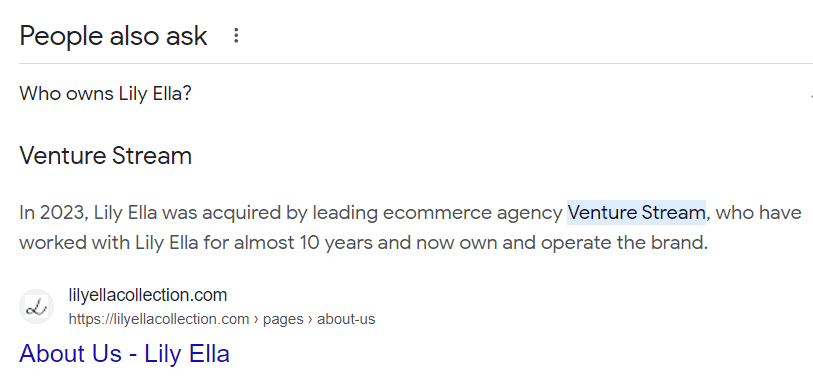Fashion ecommerce is fast-paced and crowded, so standing out is paramount. To make it to the top of the SERPs, fashion brands need to embrace the latest trends not only in their product offering but in the world of digital marketing, too.
In this blog post we’ll delve into four powerful SEO strategies that we’ve implemented for our own fashion clients.
Trend & product focused content marketing
Standout
Content marketing is a key component of any fashion brand’s marketing strategy. Standout specialises in designer menswear from the most popular premium designers, including Tommy Hilfiger, Adidas and Calvin Klein.
We’ve worked with the brand for years, creating and regularly updating blog content around the latest men’s fashion trends, styling tips, detailed product guides and seasonal gift guides, establishing the brand as an authority in its niche. This approach has helped to improve the site’s organic visibility considerably, and the Standout blog now ranks for relevant, long-tail keywords like “what to wear with grey joggers” (390 searches per month) and “mens summer fashion” (4,400 searches per month).
Our content marketing strategy extends to offsite content as well. In the fashion sector in particular, SEO and PR work hand in hand together. We began to form connections with fashion bloggers based on a few key factors: website traffic, domain authority and (most importantly) the quality and relevancy of their content. We also regularly pitch for relevant PR placements and features in highly regarded publications that the brand’s target audience looks to for product recommendations.
Why it works:
We know that search engines favour fresh, relevant content, but ultimately we need to be writing for people first. And specifically, Standout’s target audience – what type of content would they find useful? By using keyword research to identify long-tail keywords and search trends, we’re able to continuously update the Standout website with new and informative content that answers questions, offers value and caters to every stage of the purchasing funnel.
By gifting products to relevant bloggers and publications who are trusted by Standout customers, we were able to acquire a steady stream of high quality backlinks to the Standout website, helping to boost Standout’s own domain authority and traffic, which in turn helped to boost organic search visibility.
Improving website menu structure & taxonomy
Barbour
After working with Barbour for many years, in 2020 it was time to undertake a taxonomy project to improve the website’s menu structure. We found that the menu structure at the time was not optimised for search engines, and created a poor user experience due to products not being properly ordered with appropriate headers.
We began with a review of the current menu and category menu performance, followed by keyword research to suggest appropriate optimisations for existing categories and identify opportunities for new ones.
After a successful launch for the UK site, we rolled out a similar strategy for Barbour US, ensuring collections were optimised for US search terms such as “vests” instead of “gilets” and “sweaters” instead of “jumpers”.
Why it works:
A well organised taxonomy helps search engines to crawl and index your pages more effectively, resulting in better organic search visibility and higher search rankings. Keyword research is an integral part of this process, as you need to ensure you’re targeting the right keywords for your fashion brand. The UK site has seen a 44% increase in keywords when compared to this time last year, while the number of keywords the US site ranks for has increased by a huge 280%.
Optimising product pages
Yogamatters
The active wear sector is a huge part of the fashion industry which has only risen in popularity since the pandemic in 2020. When it came to designing a new Shopify Plus website for Yogamatters, we knew this was an opportunity to utilise product pages to increase organic search traffic and conversion rates at the same time.
As fashion is an inherently visual industry, online shoppers often rely heavily on images to make informed purchasing decisions, so we ensured each product template included multiple, high quality images and videos, with appropriate alt tags and sizing so as not to slow down page speed.
Product pages were also marked up with structured data, with reviews embedded to increase conversion rate, click through rate and to help the brand to stand out in the SERPs.
Why it works:
Your website’s product pages are a major factor in driving organic traffic and converting website users – they’re arguably the most important part of any ecommerce website. However, many brands neglect them by using duplicate product descriptions and poor quality images.
Implementing a keyword strategy, writing detailed product copy, uploading clear imagery and using customer reviews to your advantage can signal to search engines that your product pages are high quality, and help you stand out in the SERPs with rich snippets, leading to higher click through and conversion rates. Read our full guide to optimising your website’s product pages to find out more about how to achieve this for your own brand.
Content for every customer touch point
Lily Ella
You may have heard that we recently acquired our long-time client, Lily Ella. Specialising in elegant womenswear, we knew that we needed to build a new website that not only reflected the brand’s values and aesthetic, but offered a better user journey than the previous site.
The customer journey comprises multiple touchpoints, and each touch point may involve a search. We knew that the takeover was going to cause some uncertainty among Lily Ella’s loyal customers, especially as they are an older demographic who are generally more cautious about online ordering.
We utilised the website’s FAQs page to answer key queries such as “who is running Lily Ella” and “who owns Lily Ella” so we could address these concerns directly and build trust. Many brands fail to address potentially negative customer experiences with their own on-site content, but this will only cost you sales.

Nestle is a prime example of this – search ‘is Nestle bad’ on Google, a string of negative articles appear. The Nestle website appears nowhere on the first page of results, meaning that any potential customers in the research phase may be lost.
Why it works:
Just like product reviews, answering frequently asked questions and marking up pages with the relevant structured data can lead to your site gaining rich snippets in the SERPs. Rich snippets mean you take up a more prominent position on the page, and they present your brand as an authority on the subject in question.
You can see from the above screenshot that when searching for ‘Lily Ella’, a negative news article appears about the business going into liquidation. But just below in the ‘People Also Ask’ section, you’ll find one of our FAQs, which we’ve answered via our content.
Struggling to stand out in the SERPs? We can help with that – send us a message and we’ll be in touch.

